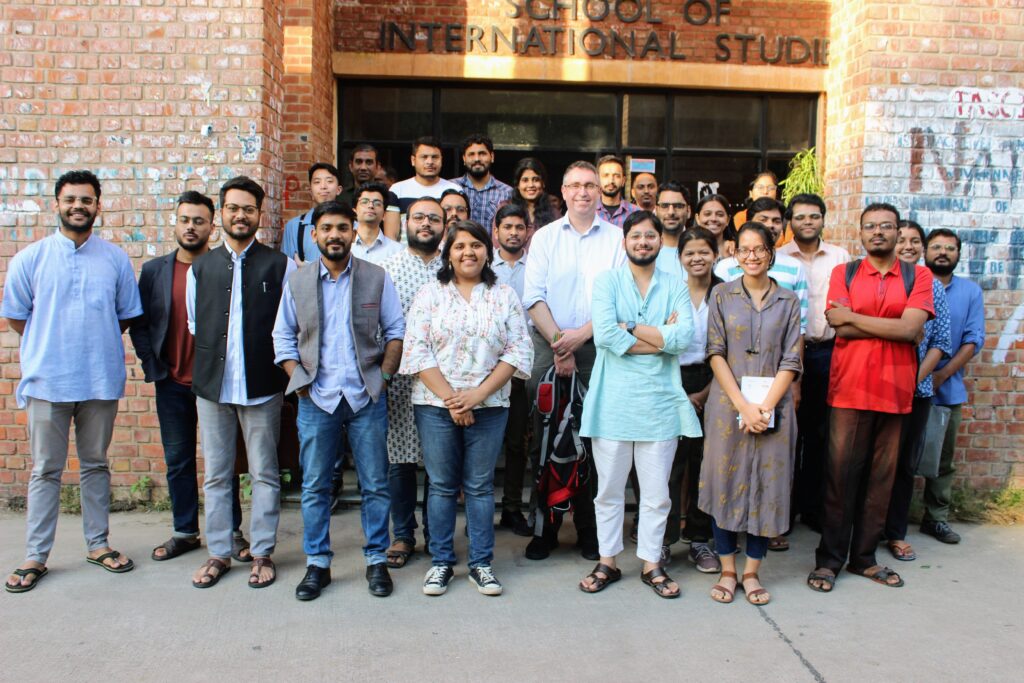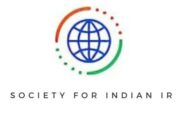
This blog provides the transcript of Candid Chat #4. Conducted on 18th October 2022, the discussion session featured Ian Hall, a Professor of International Relations at the Griffith Asia Institute. The conversation has been edited for the sake of brevity and clarity.
In your book on Modi’s foreign policy during his first term, you have argued that the swadeshi ideology, as well as the China factor, explain the reticence towards a fuller embrace of economic liberalisation. In light of later developments, including opting out of the RCEP agreement while attempting to finalize bilateral free trade deals with a host of nations, what role do you see for domestic ideology or interest groups in driving the policy?
India’s trade and investment policies are shaped by the confluence of different interest groups, making it difficult for India to join “high-quality” multilateral agreements such as the Regional Comprehensive Economic Partnership (RCEP) or the Trans-Pacific Partnership (TPP). Ideologically, there are groups that fear China’s growing influence and its potential to undermine India’s economic power. Additionally, agricultural communities in India are concerned that more liberalization will adversely impact their livelihood. The most influential factor, however, is the large industrial conglomerates linked to business families such as Reliance, who are unwilling to face outside competition to maintain their existing position over the Indian economy. Thus, India’s economic policy has an ideological orientation, but the impact of domestic interest groups on policy change is also significant.
In the aftermath of the war in Ukraine, has India truly abandoned its policy of multialignment? Evidence from India’s behavior suggests that New Delhi still leans towards multialignment, defying the West’s expectations of a harsher response to Russia’s actions. Does this assessment need to be re-examined?
The need for re-assessment must be contextualized based on the implications of the Russia-Ukraine war, which has still not abated. India’s historical ties with Russia, its support in ramping up India’s defense sector, and willingness to transfer advanced technology must be considered to make sense of India’s reluctance in openly criticizing Russia. Accounting for Russia’s support to India’s nuclear program further complicates India’s stance in the war. India’s armed dependence on Russia will continue for years to come. India’s defense reliance shapes its views of Russia, even when its aggression contradicts India’s commitment to the maintenance of territorial integrity and sovereignty of states in the world community.
As India battles to mitigate the economic effects of COVID-19, its purchase of cheap oil from Russia during the war does not necessarily signal India’s diplomatic outreach in support of Russia’s war efforts. Rather, it suggests India’s prioritisation of economic well-being of its citizens in a challenging economic scenario. However, India’s reliance on non-alignment as a foreign policy behaviour might undergo a shift based on the fallout of the war. Thus, it remains to be seen whether any such shift will occur in the foreseeable future.
In contrast to Australia-China trade relations, the volume of India-Australia bilateral trade leaves a lot of scope for improvement. In this context, what can India and Australia do to strengthen their partnership in the science and technology sector? Despite all the geopolitical developments, is there potential for India to collaborate with Australia in this domain?
China and Australia share complementarity in their economic interests, leading to a surge in trade relations over the past decades. Australia exports coal and iron ore to China which has significantly boosted the Chinese economy. Similarly, India has also improved its trade relations with Australia, although the level will not match China’s trade basket.
Both countries are doing much more in the defense and security domain, as well as in the science and technology sector. In terms of multilateral initiatives, Quad has established working groups on different issues such as Artificial Intelligence, cyber security, and Quantum technology to facilitate collaborative development in these niche areas. Bilaterally, Australia recently invested in setting up a Cyber Centre in Bangalore. It appears that Australia has put its money on India’s know-how, which will be beneficial not only to India but also to the region.
Moreover, Australia has access to critical minerals, most notably Lithium, and is looking for countries to process them into electrical batteries. In this space, India can take advantage of providing technological know-how to expedite such conversions. There is a greater scope for cooperation in this domain, and both countries will eventually deepen their partnership.
In order to foster greater collaboration, bilateral cooperation in the STEM field should be prioritized, along with providing institutional support to connect universities from both sides. This could include offering attractive fellowships, PhDs and establishing chairs in relevant departments. There is a significant potential to deepen the relationship in this area.
Historically, how has India engaged with the Liberal International Order (LIO)? Are there any continuities or changes in Indian responses from the Nehruvian era to the current dispensation? How might the growing US-India relations be affected by Modi’s illiberal turn when dealing collectively to counter the Chinese threat?
India has long been a supporter of the Liberal International Order and a proponent of institutionalism. However, this idea began to regress in Indian thinking when Nehru championed the Global South cooperation and the Non-Aligned Movement (NAM). In recent years, there has been a deliberate recourse to the term “rules-based order” which is often conflated with the LIO, but is distinct in its conceptualization. Japan has been a major proponent of this idea and has successfully persuaded India to accept it. This ideational construct deliberately incorporates more inclusivity, as most states in Southeast Asia are authoritarian, and the preaching of liberal values such as human rights and democracy do not align with their domestic politics.
The domestic situation in India is complex. There is a heated debate about India’s move away from liberalism and the decline of democracy in the country, with some fearing that more “authoritarian” features will emerge in the near future. However, countries like the US and Australia, mainly their executive authorities, have expressed their concerns in private and are encouraging India to address these issues. As there is increasing alignment in the region and issue-based collaboration takes root, these countries can’t afford to overlook India and its increasing political influence globally.
Does India have a grand strategy? What framework could best explain India’s grand strategy? How does India conduct its diplomacy with respect to its neighbors in South Asia?
India’s grand strategy, like that of other countries, ought to refer to an approach to achieve certain objectives in the world through the integration of political, economic, and military means. However, in the Indian context, there may be some hesitation in using the term “grand” ,which implies an all-encompassing way of getting what one wants. Strategy itself has a certain way of explaining India’s conduct in a particular context. But, a long-term vision of coherent processes working together to shape the international structure is not what India’s grand strategy looks like. Nevertheless, there is sufficient scope to understand India’s strategic thinking, and a possible research synopsis idea might be to investigate India’s grand strategy post-1991.
The critical and emerging technologies of our era are evolving rapidly, but the existing regulatory framework is inadequate to effectively regulate the usage and spread of these technologies. What role can the Quad play in developing regulatory framework for critical technologies and enhance scientific cooperation among member states in these issue areas?
Given the shared value for the Quad members in sharing best practices and establishing scientific guidelines, it is possible for the group to create a regulatory framework on scientific cooperation to effectively regulate the use of such technologies. However, the challenge lies in how such smaller groupings can influence larger multilateral institutions to change international laws. Conversations on this matter are already happening, but it is essential to make a jump from smaller to bigger groupings. Some states may resent the fact that changes are being brought about by smaller groupings without their involvement. The Quad might do well to allay such concerns in order to gain greater acceptance.
When it comes to the Biden administration’s strategy, some argue that the focus on the Indo-Pacific region is to bring South-East Asian countries into the fold, but it is unclear how South Asian or South-East Asian countries will work with the Biden administration or the Quad in the broader goal of managing or confronting China. In this context, how should the US engage with the region?
There is a prevalent narrative in South-East Asia that the United States believed in the peaceful rise of China and was ultimately duped. However, this view is not shared by all. Some argue that the United States has been focused on Afghanistan and Iraq for an extended period and has pivoted its attention to the Indo-Pacific region only recently. Furthermore, in the event of a significant crisis with Iran, the United States may again be drawn back to that region. This perception of the United States in South-East Asia has led to skepticism about US promises of engagement over the past 20 years.
While there is a considerable appreciation for the US power, military capability, and influence in the region, there is also a lingering doubt about its commitment to the region and willingness to engage. The absence of a US ambassador in New Delhi, for instance, has raised concerns which reflects poorly on the US commitment to the region. As a result, people in the region are closely monitoring US actions to see where it will deploy its ships and diplomats, as actions speak louder than words.
In this context, it remains to be seen how the United States will work with South Asian and South-East Asian countries to address regional challenges, including managing China’s rise. The Quad has the potential to play a significant role in this regard by enhancing regional security and promoting democratic values. However, it is essential that the United States addresses the doubts and concerns of its partners in the region to build trust and ensure that the partnership is effective in achieving its goals.
In light of recent events such as the Ukraine conflict, India’s relationships with both China and Western countries have come under scrutiny. During his foreign tours, External Affairs Minister S Jaishankar has criticizing other countries for their unilateral approach and insensitivity to India’s concerns. However, India itself appears to be hesitant to take a firm stance against China’s actions in Xinjiang and the South China Sea, causing some to question India’s behavior. How can we analyze and understand India’s approach to these different situations, particularly in terms of its relationship with China and the West?
India has historically been reluctant to openly criticise other countries, particularly on human rights issues. The reasons for this
approach can be debated, with some arguing that it is a principled position and others suggesting that it is driven by India’s own interests. India has faced criticism in the past over its handling of conflicts such as the insurgency in Kashmir or the disturbances in Punjab, and it is generally averse to being singled out for criticism by other countries or at the United Nations.
However, there has been a shift in recent years, particularly under the current government, with a more vocal and critical approach towards China. Prior to this, public criticism of China and its policies was not common. This government has been more open about pointing the finger at China, as evidenced by Jaishankar’s statement on the Belt and Road Initiative in 2017. This was unexpected, given India’s previous reluctance to criticise China. Despite this shift, India is still somewhat constrained by its concerns about its own position and perceived weakness.
The question at hand pertains to the perennial dilemma of Indian foreign policy involving its troubled relationship with Pakistan. Under the present regime, the Indian state has seemingly taken a more assertive and hawkish stance towards Pakistan. What are the key factors that influence India’s foreign policy toward Pakistan, and what do you envision for the future course of India’s Pakistan policy?
In 2014 and 2015, there were signs of some progress in India’s engagement with Pakistan, with the Modi government investing in diplomatic efforts. However, the process was derailed quickly following a terrorist attack in 2015, which highlighted the existence of vested interests within Pakistan that seek to sabotage any diplomatic overtures. These interests, primarily the military establishment, hold significant power and influence in the country, and are hindering progress towards a peaceful resolution of the long-standing conflict between the two nations.
The question of how to diplomatically engage with actors who have a track record of using terrorism as an instrument of state policy remains a challenging one. While back channel negotiations continue, it is unclear whether any tangible progress can be made without accepting the risk of further terrorist attacks. Thus, the question of India’s future policy towards Pakistan is a complex and nuanced one, requiring a deep understanding of the country’s internal politics and external relationships.
In your paper on India’s normative power, you discuss a transition from the Nehruvian exceptionalism to Modi’s Hindu nationalism. In light of the growing international criticism of India’s illiberal turn, how much currency shall the Modi government’s vishwaguru narrative hold?
In my understanding, the Indian government’s projection of India as a normative power has primarily been for domestic consumption. While there certainly are people who believe in the concept of India as a “Vishwaguru”, this idea is largely unknown outside of India. Further, India’s soft power is difficult to measure and has not necessarily increased through initiatives such as International Yoga Day.
However, it is true that this messaging is often undermined by various factors, including lackadaisical economic development. For example, in my interactions with Malaysians, I have found that they are particularly concerned about the situation in Kashmir and the constitutional changes made by the Indian government. This has led to a mixed view of India in Southeast Asia, with many feeling that the country is not moving quickly enough or at the right pace and that its economic growth is not fast enough. All these factors serve to erode the normative power that India is seeking to project on the global stage.
(Discussion Transcript by Rahul Jaybhay and Vishwajeet Singh Akhawat, Edited by Sanjeet Kashyap)

